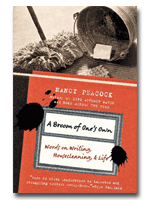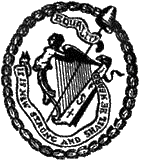
I recently read a book called A Broom of One’s Own: Words on Writing, Housecleaning, and Life by Nancy Peacock. Though I’ve never read one of her novels, on the strength and entertainment value of these essays I’m going to buy one immediately!
Peacock talks about both the life of the writer, the artist, and her old ‘day job’ of housecleaning, what she learned from the work and the people whose houses she cleaned. (I must say, the chapter on the Hamiltons made me feel much better about my own lackluster housekeeping! At least I always put my candy wrappers and used Kleenex in the trashcan). She says several things I could identify with in my own weird odyssey of writing books.
From page 20, on writing full-time for a year: “…I did miss having something in my life besides writing. Writing itself had not become a strong enough foundation yet, and without the foundations of regular work I felt like an emotional mudslide. I was caving in on myself. Living alone, probing a fictional world for six hours a day, was making me feel a little weird…I was discovering, in fact, that writing full-time was inefficient. I found that I could write effectively for two or three hours each day. After that, time spent at the desk was time spent mucking up my characters’ story. I’d lost the ability to listen to them.”
From Amanda–I’ve never cleaned houses for a living (see above, those lackluster cleaning skills–no one would pay me to do that!), but I do work a “day job”, working in a library/archives and doing an occasional newspaper story. I relish holidays, when I have long stretches of time where I can stay home and really get ahead on a book, but I’m never too sorry to go back to work, either. I dream about being a full-time author, but the truth is I need the structure of the day job. It makes my writing time more precious, more efficient. I have to get right to the point of the story every day when I sit down with my pen. And it keeps me from watching soap operas and sitting around in Hello Kitty pajamas all day!
From page 53, on publishing one’s work: “I think that in the beginning of my writing life I believed that writing, publication in particular, could, besides making me rich, also make me invulnerable. It might have been the stupidest thought I ever had, because there is nothing, with the exception of love, that has ever made me feel more vulnerable than writing and publishing.”
From Amanda–amen to that! I think that writing (the world of romance publishing especially, perhaps) sets up a sort of “magic door” way of thinking. Once we sell our work, all will be wonderful! I may have thought that once. But publishing just opens up a whole new world of concerns and, yes, vulnerabilities. I’m not magically more self-confident because my book now has a cover and sits on a bookstore shelf; in fact, I am less. Ack! It’s making me nervous just thinking about it all!!!
From page 72–73: “Writing is so crazy. There must be a million things to do that are saner than writing…It feels a little like living a double life. It feels secretive. If one of my characters suddenly dies, and I am moved to grief, or even tears, I can’t share that with anyone.
“I think this is why I thrive on routine. I like for the real life, the one that involves going to work and cooking dinner and being in the physical world, to be somewhat predictable, because there are enough surprises in the alternate life.”
From Amanda–okay, so this is why I have a much harder time writing when my routine is messed up! (When it’s Christmas, for instance, or there’s an illness in my family, or I’m helping my brother’s fiancee get ready for their wedding in May). My alternate world keeps getting interrupted. And it is an alternate world. I may appear to be grocery shopping or cooking a pot of pasta, but in reality I’m trying to figure out how to unravel my latest plotting problem, or trying out bits of dialogue aloud…
And on page 23: “I think there are two things writers love more than anything else. One is solitude and the other is gossip. In the housecleaning trade I got both, but in all the jobs I worked before housecleaning there was too much gossip and not enough solitude. These jobs exhausted me.”
From Amanda–LOL! My last job involved a great deal of inter-personal conflict (not with me–between other co-workers, but they always wanted to tell me all about it). This current job suits me very well. Most of the work is on my own, but sometimes people in the offices next door come by and chat, and I eat lunch with them. This gives me time to think, to let my stories percolate in my mind, but keeps me from going bat-crazy. And there is always something interesting going on here! I like to take breaks a couple times a day to check in with the Riskies and other blogs.
What about all of you? Do you have a “day job”? How does it help/hinder your writing? What is your perfect balance of solitude and gossip?
And don’t forget! On April 6, I will be blogging at Unusual Historicals, with a chance to win a copy of A Sinful Alliance! It’s on shelves now, and my mother says it is very good. 🙂















